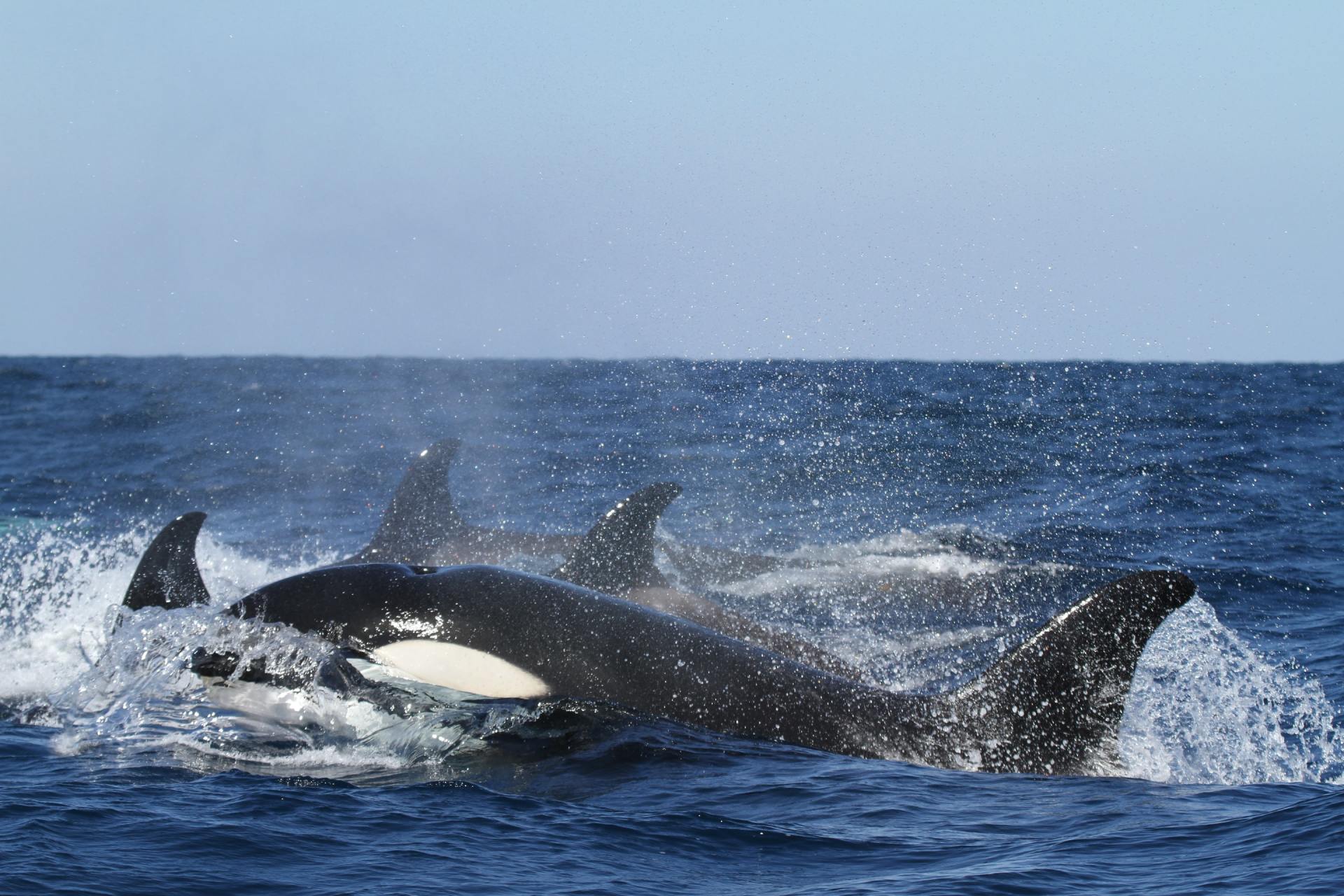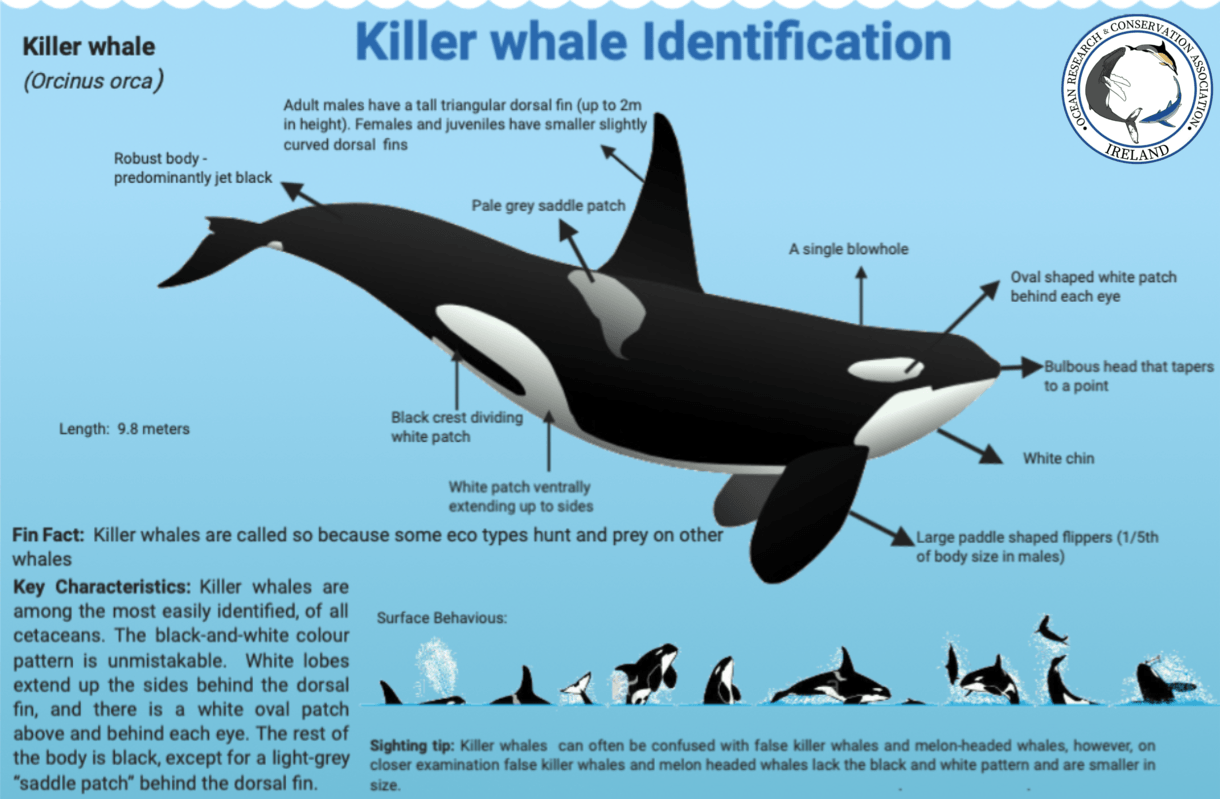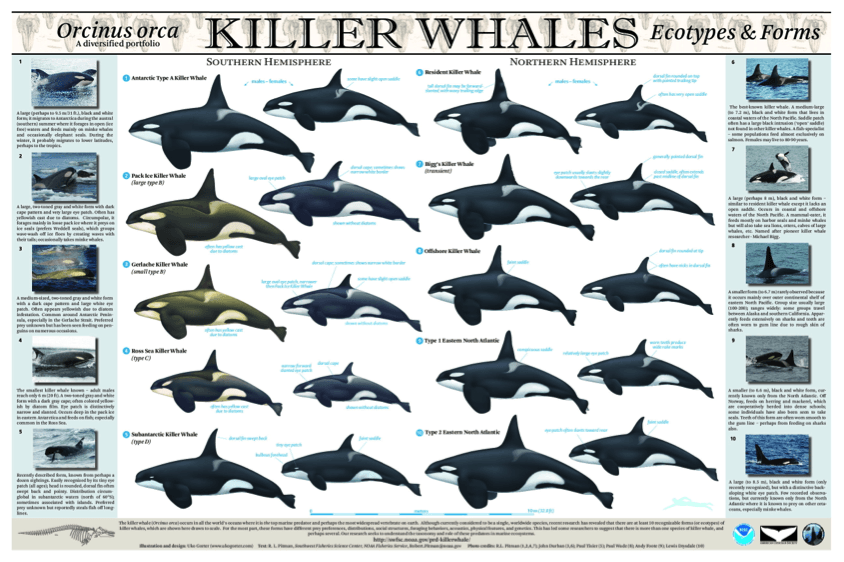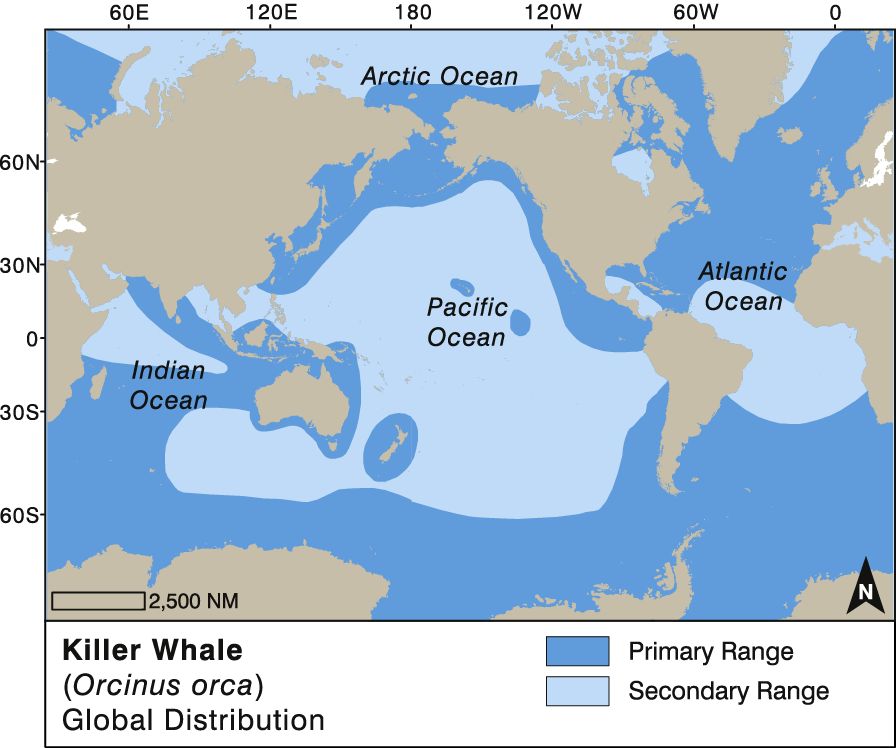Killer Whale
Killer Whale
(Orcinus orca)
Killer whales (Orcinus orca)
Next Species ----->
<----- Previous Species
Classification:
Kingdom: Animalia
Phylum: Chordata
Class: Mammalia
Order: Artiodactyla
Infraorder: Cetacea
Family: Delphinidae
Genus: Orcinus
Species: Orcinus orca
I nGaeilge:
An Chráin dhubh
Get the Facts:
Killer whales (Orcinus orca), also known as "blackfish" are toothed cetaceans and are the largest members of the dolphin family. Killer whales can weigh up to 6 tons or over 5,000 kilograms and reach 9.7 meters in length. Killer whale populations have diverse diets, with some specialising in hunting fish, others in marine mammals and in some parts of the world, even sharks. Their common name "killer" comes from the animals ability to hunt and prey upon large marine mammals such as seals, dolphins and even other whales. Originally sailors called O.orca "whale killers" (asesina ballenas) - a term that was eventually flipped around to "killer whale". Later captive facilities such as SeaWorld popularised the name Orca referring to their scientific name - to reduce fear in members of the public that these whales may be dangerous to humans. Killer whales have never been documented to harm people in the wild, however there have been fatalities at in captive killer whales. For example, a captive killer whale named "Tilikum" who was captured from the wild in Iceland when he was 2 years old and spent most of his life performing at SeaWorld Orlando, Florida, sired 21 orca's for captivity, 10 of which are still living in captivity, was involved in the deaths of three SeaWorld trainers. This gained much media attention in the documentary Blackfish,
now available on Netflix.
Species Identification:
Killer whales are easily distinguishable from other cetacean species due to their stand-out black and white colouration. Bull males have a tall triangular falcate dorsal fin that can reach 2 meters in length. Females have a smaller, slightly crescent shaped dorsal fin. They have a white patch behind their eye which varies with size and shape depending on the "eco-type". Ten different eco-types of killer whales have been described. They also have a light grey saddle patch behind their dorsal fins, which also varies depending on which population and area of the world the whale is from. They have paddle shaped pectoral fins or flippers and a white chin and underbelly. Upon surfacing their head usually breaks the waters surface and a blow is visible.
Diet:
Killer whales are considered apex predators as nothing in the ocean hunts them and they are the largest known marine mammals to attack and consume other mammals. Killer whales diet is highly variable depending on where they live. The primary diet of most killer whales include a variety of fish such as herring, cod, hake and several other small aquatic species, although they may also consume squid and octopus. Killer whales that live near land have also been known to attack and eat other marine mammals., such as seals, sea lions, walruses, penguins, seabirds, sea otters and even whales. Other marine species reported in killer whales stomachs include sharks, polar bears, reptiles and moose. Killer whales that visit Irish waters come from the Scottish West Coast Community. These are Type 2 killer whales which are mammal eating whales and have been observed hunting seals, dolphins and minke whales.
Habitat:
Depending on the ecotype, killer whales may exploit a variety of habitats, from shallow coastal areas to deep waters off the continental shelf.
Type A killer whales prefer living offshore and in ice-free waters.
Type B killer whales prefer inshore waters of the Antarctic Peninsula and the Antarctica.
Type C killer whales prefer both pack ice and the inshore water of eastern Antarctic.
Type D are known to prefer deep waters, but the sightings are quite few in number.
There are two populations of killer whales that are seen in Irish waters. One group is of the resident population of Type 2 North Atlantic killer whales known as the Scottish West Coast Community that are generally based around the Hebrides, and north west coasts of Scotland, however recent sightings also include the Firth of Clyde and Orkney. These whales particularly "John Coe" W01 and "Aquarius" (W08) have been known to range to the west of the British Isles, from the southern Irish Sea and west along the entire length of Ireland’s Atlantic seaboard. These Type 2 killer whales prey exclusively on other marine mammals such as porpoises, dolphins, whales and seals and have been observed in coastal waters. A second offshore population of Type 1 North Atlantic killer whales has also been documented in Irish waters, where whales depredate and forage around commercial pelagic mackerel trawlers and purse seine fishing activity.
Behaviour:
Killer whales display a variety of complex behaviours which includes breaching (jumping), travelling, tail slapping and socialising through acoustic vocalisations and tactile (touch) behaviours. A killer whale may thrust itself completely out of the water and then land on the surface of the water with a huge splash. This behaviour is termed as breach. A killer whale may rise vertically exposing only its head. This behaviour is termed as spy-hop. Sometimes a killer whale may make loud sounds either under the water or above it by lob tailing, dorsal fin slapping and pec-slapping.
Social Structure:
The social structure of the killer whale is quite complex and stable. Males live with their mothers for their entire lives, and thus have a matrilineal society. Social hierarchy exists amongst the killer whales where the females are dominant. Killer whales familial pods consists of an old female and her sons and daughters along with the descendants of her daughters. Since the life expectancy of a female killer whale is almost 90 years, up to almost 4 generations stay together. Individual killer whales usually separate from the group for only a few hours, known as fission-fusion social structure, similar to other members of the dolphin family.
Vocalisations:
Killer whales produce sounds for two overlapping functions: communicating and navigation (in the form of echolocation). Killer whales produce whistles, echolocation clicks, pulsed calls, low-frequency pops, and jaw claps. A killer whale makes sounds by moving air between nasal sacs in the blowhole region. A tissue complex in a toothed whale's nasal region, called the dorsal bursa, is the site of sound production. This complex includes "phonic lips" (sometimes called "monkey lips") — structures that project into the nasal passage. Toothed whales make at least some sounds by forcing air through the nasal passage and past the phonic lips: the surrounding tissue vibrates, producing sound. Releasing air isn't required for sound production. During some vocalizations, killer whales actually release air from the blowhole, but these bubble trails and clouds are probably a visual display. Vocalisations of killer whales recorded include echolocation clicks, burst-pulse sounds and whistles. The frequency of the fundamental contours of all call types ranged from 600 Hz to 29 kHz. Calls ranged from 0.05 to 11.3 seconds in duration.
Reproduction:
Adult female killer whales give birth to a single baby about every 3-10 years. They start breeding at about 14-15 years of age (the youngest known was only 11). Gestation is 16-17 months. Calves nurse for about one year. Almost half of all the calves die within their first year. Females only reproduce for about 25 years before entering into menopause similar to humans, at about 40 years old. Therefore, each female only produces about 4-6 surviving offspring in her life. Male killer whales mature at about 12-14 years old. They reach full size at about 20 when the tall dorsal fin and droopy flukes become obvious. Before that, young males are hard to tell from young females unless they breach (to see the mammary slits) or display their penis (which they may do in play).
Lifespan:
Females live an average life of 50 years, but there are some that are estimated to be over 90 years old. J2, the killer whale known as "Granny", the matriarch of the Canadian Southern Resident J-pod was likely born in 1911, making her an astounding 105 years old before she died. Granny was last seen in October 2016. Males live an average life span of only 29 years, but some have lived to 50-60 years old.
Killer Whales of the World:
Over the last decade researchers have determined that there are 10 different forms of killer whales, known as ecotypes. These distinct types of orcas vary in size, appearance, prey preferences, foraging techniques, dialects, behaviours, and social groups. The different ecotypes ranges may overlap, but they are genetically distinct, meaning they do not appear to interbreed, and rarely interact with other ecotypes. In the Northeast Atlantic there are two forms, TYPE 1 and TYPE 2;
Type 1: Noth Atlantic orcas are generalist foragers. relatively small and live in closely related pods. They are known to feed on large runs of herring and mackerel around Norway, Iceland, and Scotland; and some have been seen hunting seals as well. Like other orca ecotypes, different communities have different prey preferences and have different home ranges. Type 1 orcas off Norway have been observed using a carousel feeding technique, herding herring into dense balls, then slapping with their tails to stun the fish. Research on Type 1 orcas is ongoing, and photo-identification studies are gradually revealing the size and population structure of these orcas; they may be more divided into separate populations than previously thought.
Type 2: North Atlantic orcas prey primarily on other whales and dolphins, particularly minke whales. They are large orcas with distinctive back-sloping eye patches. Similar to the different ecotypes in the Pacific, the prey specialisations of Type 1 and Type 2 orcas are reflected in their teeth – Type 1 orcas have very worn teeth from feeding on fish, while Type 2s have larger and sharper teeth for hunting other mammals.
To find out more read our Blog and click; "ORCAS IN IRISH WATERS".
Global Distribution:
Killer whales are found in all the oceans of the world, but they prefer higher latitudes and also the coastal areas that come in the pelagic zone. According to a survey, the highest density of the killer whales is found near the northeast Atlantic, north Pacific and in the southern Ocean. Also, they are considered as quite common on the eastern Pacific and around the North Atlantic Ocean. . Killer whales also range in temperate and tropical areas as well, taking advantage of temporary or seasonal feeding opportunities. Killer whales have been recorded in the Strait of Gibralter, Florida, Hawaii, Australia, the Galapagos Islands, the Bahamas, and the Gulf of Mexico, and more temperate waters such as New Zealand and South Africa. Rarely, killer whales have been seen in fresh water rivers around the world such as the River Lee, the Rhine, the Thames, and the Elbe. Studies of movement patterns of fish-eating North Atlantic killer whales indicate that populations of these whales follow the movements of herring (Clupea harengus) in Icelandic and Norwegian waters and of mackerel in Scottish waters.
Population Status:
It is estimated that their global population is at least 50,000. Estimates of the abundance of North Atlantic killer whales, produced from North Atlantic Sighting Surveys 1987-2001 was 15,014. According to the IUCN Red List, killer whales are Data Deficient. The southern resident community of killer whales are Endangered. Type 2 killer whales, known as the Scottish West Coast Community, who are specialist feeders, primarily hunting baleen whales, porpoises, dolphins and seals are Critically Endangered. There is only 8 individuals left in the population. Killer whales in Gibraltar were also classified as Critically Endangered.
Conservation Threats:
Threats to killer whales in the North Atlantic include harvest or whaling, chemical pollution, climate change and prey availability, interactions with fisheries and acoustic disturbance. As recently as 2018, nine killer whales were killed in St. Vincent in the Caribbean. High polychlorinated biphenyl (PCBs) concentrations were measured in full blubber-depth and biopsy samples taken
from North Atlantic killer whales. Contamination patterns are variable across regions and are presumably a reflection of differences in diet, trophic level, and proximity to industrialised coastlines. The most heavily contaminated killer whales are those sampled in Gibraltar, Canary Islands, UK and Ireland, and marine-mammal eating killer whales sampled around Greenland. A result of pollution has been reproductive failure in female killer whales sampled around the very industrialised regions of the Canary Islands and Gibraltar. PCBs, along with the next most common groups of contaminants (chlordanes and DDT), occur in blubber concentrations exceeding thresholds that cause physiological, reproductive and immune impairments. Climate change and the subsequent loss of sea ice promote pelagic-dominated habitats and make new prey resources available to killer whales in Polar regions. The recently warming marine climate has promoted major shifts in the distribution and abundance of killer whale prey resources in the North Atlantic. low prey supplies may lead to decreasing body condition in specialist individuals and to potential population-level consequences through lower survival and reproduction rates. Killer whales have been observed scavenging on discarded fish around herring purse-seiners off Iceland and Norway, around mackerel trawlers in the North Sea, around Greenland halibut longliners off northern Labrador and in the Davis Strait, and around trawlers and gillnets in Northwest Atlantic. Acoustic disturbance from anthropogenic sources such as sonar sounds used in naval activities results in responses of variable severity by North Atlantic killer whales. These include disruption of diving behaviour and feeding, separation of group members, and source avoidance leading to displacement; subsequent costs relate to loss of habitat and reduced foraging success.







